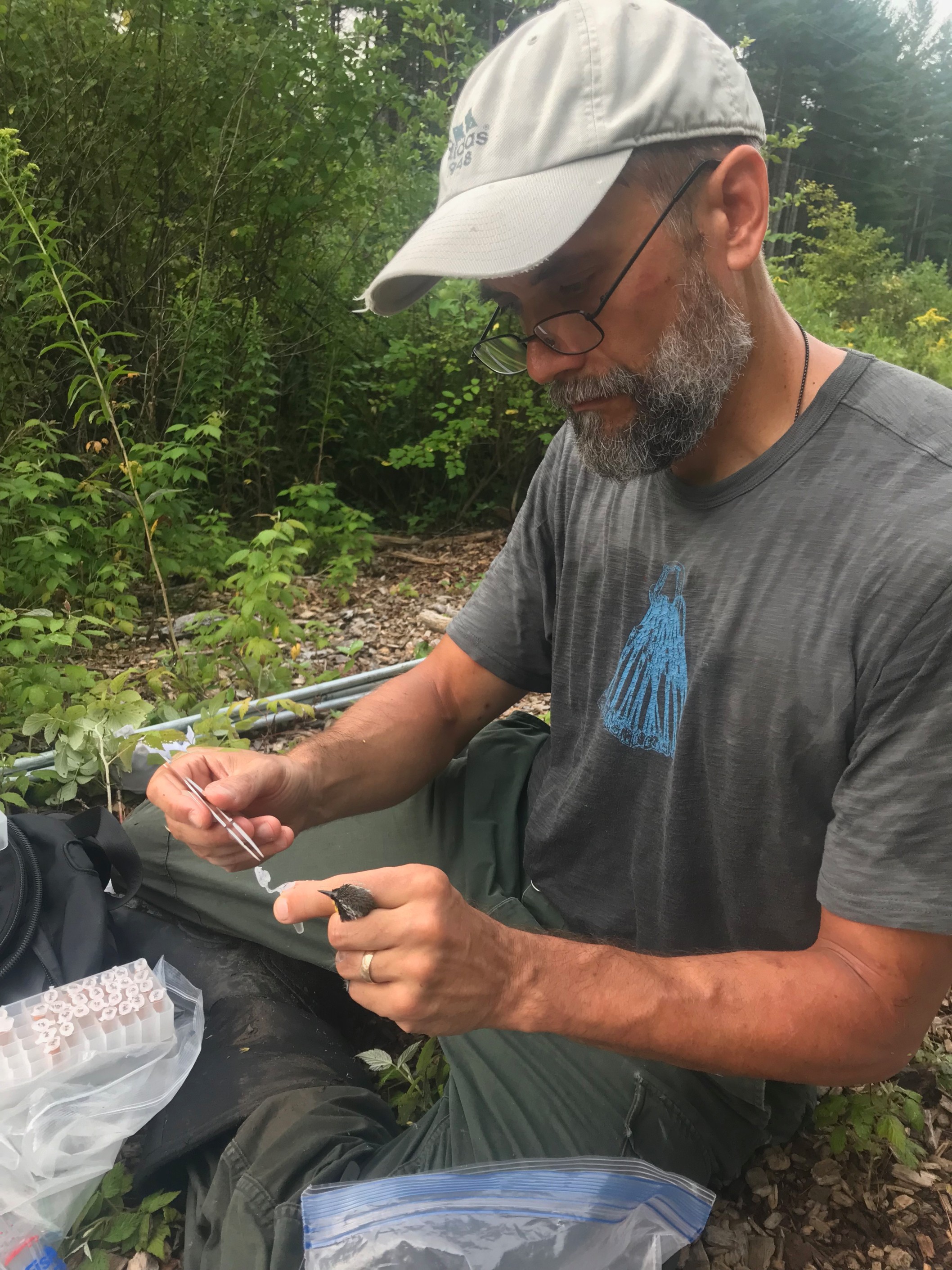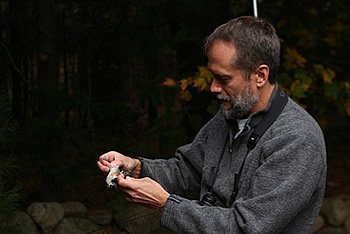Corey R. Freeman-Gallant
Professor of Biology, ADOF, Student Academic Affairs

Office: Dean of Faculty’s Office, Palamountain 416
Lab: Annex 120
Telephone: (518) 580-5086
Email: cfreeman@skidmore.edu
EDUCATION:
- PhD, Ecology and Evolutionary Biology, Cornell University, 1997
- AB, Biology, Bowdoin College, 1991
RESEARCH AND TEACHING INTERESTS:
My research uses field and molecular techniques to explore the evolution of ecologically
important traits in birds. In the field, I combine observational and experimental
work on color-banded individuals to describe the costs and benefits of avian life
history decisions. In the laboratory, I use hypervariable genetic markers to describe
patterns of gene exchange within and among populations. Current projects with Savannah
Sparrows (Passerculus sandwichensis) and Common Yellowthroats (Geothlypis trichas)
explore the adaptive significance of avian reproductive behavior and signaling systems.
Most recently, my work has focused on the evolution of male and female plumage displays,
and I am currently exploring the interrelationship between cell-level processes (telomere
dynamics, oxidative stress), carotenoid-based plumage ornaments, and the fecundity
and survivorship of adults.
Undergraduates participate in both the field and laboratory components of my research,
and I view as essential the active learning that student-faculty collaboration engenders
in its participants. Science is not a body of knowledge to be passively absorbed by
students but a process of active inquiry that is most effectively taught by doing.
In my courses, students engage in all aspects of scientific research: they work independently
or in small groups to generate research questions, to devise methods of evaluating
their hypotheses, and to communicate their results to the larger community. This approach
to science education demands much of students, but it also captures the excitement
and challenge of scientific inquiry.
TEACHING AND RESEARCH INTERESTS: evolutionary ecology, animal behavior, avian biology, molecular ecology
 COURSES:
COURSES:
- Ornithology (BI-307)
- Evolution (BI-224)
- Organismal Biology (BI-108)
RECENT PUBLICATIONS:
- Wheelwright NT, Freeman-Gallant CR,Mauck RA (2022) Nestling Savannah sparrows and tree swallows differ in their sensitivity to weather. Ornithology (in press)
- Sly ND, Freeman-Gallant CR, Henschen AE, Minias P, Whittingham LA, Dunn PO (2022) Molecular parallelism in signaling function across different sexually selected ornaments in a warbler. Proceedings of the National Academy of Sciences, 119: e2120482119.
- Taff CC & Freeman-Gallant CR (2021) Female ornamentation, incubation behavior, and reproductive success in a wild bird. Behav Ecol Sociobiol 75: 92.
- Freeman-Gallant CR & CC Taff (2018) Age and infection history are revealed by different ornaments in a warbler. Oecologia 188: 1025-1036.
- Taff CC, Freeman-Gallant CR, Streby H, Kramer G (2018) Geolocator deployment reduces return rate, alters selection, and impacts demography in a small songbird. PLoS ONE doi.org/10.1371/journal.pone.0207783
- Williams H, Robins CW, Norris DR, Newman AEM, Freeman-Gallant CR, Wheelwright NT, Mennill DJ (2018) The buzz segment of Savannah sparrow song is a population marker. Journal of Ornithology doi.org/10.1007/s10336-018-1611-7
- Whittingham LA, Dunn PO, Freeman-Gallant CR, Taff CC & JA Johnson (2018) MHC variation and blood parasites in resident and migratory populations of the common yellowthroat. Journal of Evolutionary Biology doi: 10.1111/jeb.13349.
- Freeman-Gallant CR & CC Taff (2017) Age-specific patterns of infection with haemosporidians and trypanosomes in a warbler - implications for sexual selection. Oecologia 184: 813-823.
- Taff CC & CR Freeman-Gallant (2017) Sexual signals reflect telomere dynamics in a wild bird. Ecology & Evolution 7: 3436-3442.
- Taff CC & CR Freeman-Gallant (2016) Experimental tests of the function and flexibility of song consistency in a wild bird. Ethology 122: 1-10.
- Whittingham LA, CR Freeman-Gallant, CC Taff, PO Dunn (2015) Different ornaments signal male health and MHC variation in two populations of a warbler. Molecular Ecology 24: 1584-1595.
- Taff CC, GL Patricelli & CR Freeman-Gallant (2014) Fluctuations in neighborhood fertility generate variable signaling effort. Proceedings of the Royal Society of London, Series B 281: 20141974.
- Taff CC & CR Freeman-Gallant (2014) An experimental test of the testosterone mediated oxidation handicap hypothesis in a wild bird. Hormones and Behavior 66: 276-282.
- Freeman-Gallant CR, Schneider RL, Taff CC, Dunn PO & Whittingham LA (2014) Contrasting patterns of selection on the size and coloration of a female plumage ornament in common yellowthroats. Journal of Evolutionary Biology 27: 982-991.
- Taff CC, CR Freeman-Gallant, PO Dunn & LA Whittingham (2013) Spatial distribution of nests constrains the strength of sexual selection in a warbler. Journal of Evolutionary Biology 26: 1392-1405.
- Dunn PO, JL Bollmer, CR Freeman-Gallant & LA Whittingham (2013) MHC variation is related to a sexuality selected ornament, survival, and parasite resistance in common yellowthroats. Evolution 213: 679-687.
- Bollmer JL, PO Dunn, CR Freeman-Gallant & LA Whittingham (2012) Social and extra-pair mating in relation to major histocompatibility complex variation in common yellowthroats. Proceedings of the Royal Society, London, Series B: Biological Sciences 279: 4778-4785.
- Taff CC, D Steinberger, C Clark, K Belinsky, H Sacks, CR Freeman-Gallant, PO Dunn & LA Whittingham (2012) Multi-modal sexual selection in a warbler: plumage and song are related to different fitness components. Animal Behaviour 84: 813-821.
- Taff CC, KA Littrell & CR Freeman-Gallant (2012) Female song in the common yellowthroat. Wilson Bulletin 124: 370-374.
- Mitchell GW, CG Guglielmo, NT Wheelwright, CR Freeman-Gallant & DR Norris (2011) Early life events carry over to influence pre-migratory condition in a free-living songbird. PLoS ONE 6: e28838.
- Freeman-Gallant CR, J Amidon, B Berdy, S Wein, CC Taff & MF Haussmann (2011) Oxidative damage to DNA related to survivorship and carotenoid-based sexual ornamentation in the common yellowthroat. Biology Letters 7: 364-367.
- Taff CC, CR Freeman-Gallant, PO Dunn & LA Whittingham (2011) Relationship between brood sex ratio and male ornaments depends on male age in a warbler. Animal Behaviour 81: 619-625.
- Freeman-Gallant CR, CC Taff, DF Morin, PO Dunn, LA Whittingham & SM Tsang (2010) Sexual selection, multiple male ornaments, and age- and condition-dependent signaling in the common yellowthroat. Evolution 64: 1007-1017.
- Dunn PO, JC Garvin, LA Whittingham, CR Freeman-Gallant & D Hasselquist (2009) Carotenoid and melanin-based ornaments signal similar aspects of male quality in two populations of the common yellowthroat. Functional Ecology 24: 149-158.
- Butler MW, JC Garvin, NT Wheelwright & CR Freeman-Gallant (2009) Ambient temperature, but not paternity, is associated with immune response in Savannah Sparrows. Auk 126: 536-542.
- Perlut NG, CR Freeman-Gallant, AM Strong, TM Donovan, CW Kilpatrick & NJ Zalik (2008) Agricultural management affects evolutionary processes in a migratory songbird. Molecular Ecology 17: 1248-1255.
- Wheelwright NT, MB Swett, II Levin, DE Kroodsma, CR Freeman-Gallant & H Williams (2008) The influence of different tutor types on song learning in a natural bird population. Animal Behaviour 75: 1479-1493.
- Dunn PO, LA Whittingham, CR Freeman-Gallant & J DeCoste. (2008) Geographic variation in the function of ornaments in the common yellowthroat. Journal of Avian Biology 39: 66-72.
- Freeman-Gallant CR, NT Wheelwright, KE Meiklejohn & SV Sollecito (2006) Genetic similarity, extra-pair paternity, and offspring quality in Savannah sparrows. Behavioral Ecology 17: 952-958.
- Mitchell DP, PO Dunn, LA Whittingham & CR Freeman-Gallant (2006) Attractive males provide less parental care in two populations of the common yellowthroat. Animal Behaviour 73: 165-170.
- Wheelwright NT, CR Freeman-Gallant & RA Mauck (2006) Asymmetrical incest avoidance in the choice of social and genetic mates. Animal Behaviour 71: 631-639.
- Freeman-Gallant CR, NT Wheelwright, KE Meiklejohn, SL States & SV Sollecito (2005) Little effect of extra-pair paternity on the opportunity for sexual selection in Savannah sparrows. Evolution 59: 422-430.
- Freeman-Gallant CR, M Meguerdichian, NT Wheelwright & SV Sollecito (2003) Social pairing and female mating fidelity predicted by RFLP similarity at the major histocompatibility complex in a songbird. Molecular Ecology 12: 3077-3083.
- Wheelwright NT, KA Tice & CR Freeman-Gallant (2003) Post-fledging parental care in Savannah sparrows: sex, size, and survival. Animal Behaviour 65: 435-443.
- Freeman-Gallant CR, EM Johnson, F Saponara & M Stanger (2002) Variation at the major histocompatibility complex in Savannah sparrows. Molecular Ecology 11: 1125-1130.
- Freeman-Gallant CR, KD OConnor & ME Breuer (2001) Sexual selection and the geography of Plasmodium infection in Savannah sparrows. Oecologia 127: 517-521
- Freeman-Gallant CR & MD Rothstein (1999) Apparent heritability of parental care in Savannah Sparrows. Auk 116: 1132-1136.
- Freeman-Gallant CR (1998) Fitness consequences of male parental care in Savannah sparrows. Behavioral Ecology 9: 486-492.
- Freeman-Gallant CR (1997) Extra-pair paternity in monogamous and polygynous Savannah sparrows. Animal Behaviour 53: 397-404.
- Freeman-Gallant CR (1997) Parentage and paternal care: consequences of intersexual selection in Savannah sparrows. Behavioral Ecology and Sociobiology 40: 395-400.
- Freeman-Gallant CR (1996) Microgeographic patterns of genetic and morphological variation in Savannah sparrows. Evolution 50: 1631-1637.
- Freeman-Gallant CR (1996) DNA fingerprinting reveals female preference for male parental care in Savannah sparrows. Proceedings of the Royal Society, London, Series B: Biological Sciences 263: 157-160.
- Danforth BN & CR Freeman-Gallant (1996) DNA fingerprinting data and the problem of non-independence among pairwise comparisons. Molecular Ecology 5: 221-227
